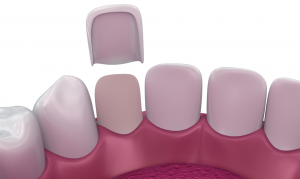What are Veneers?

Dental veneers are a probable solution to help you get the perfect smile you want. They are a well-liked option for individuals with chipped teeth, a gap among teeth, or misshaped teeth.
Dental veneers are thin covers that hold on to teeth to give teeth a more proper look.
Why Get Dental Veneers?
If you want to improve your smile and your self-esteem, dental veneers are a simple option. Veneers are thin layers that are positioned over the front (visible) part of the tooth. They look like normal teeth. Veneers can be used to correct a variety of dental issues, for instance:
- Uneven spaces or a large gaps between the upper front teeth
- Chipped or worn teeth
- Teeth that are stained and couldn’t be whitened by bleaching
- Crooked or misshapen teeth
Choose the material that’s best for you. Each type of veneer offers its own advantages. Veneers are made of either composite resin material or porcelain.
Porcelain
A porcelain veneer is a thin shell that is specially made to fit on the tooth.

Benefits of porcelain veneers:
They have a natural-looking surface
They are strong and long-lasting
They don’t stain easily
A ceramic veneer is placed
Less tooth enamel wants to be removed than with a crown or cap
Steps to Place Porcelain Veneers:
To arrange the teeth, the dentist normally gets rid of a small amount of enamel from the front and sides of the teeth. This creates room for the veneers so that your teeth appear natural.
The dentist creates an impression, or mold, of the prepared teeth. The dentists as well choose on the veneer colour that will be best for you.
The impression is then sent to a dental lab that custom-makes the porcelain veneers to fit your teeth. This might take several days. The dentist might give you temporary veneers to wear at the moment.
At the next visit, the dentist sets the veneers on the teeth to make sure the fit and shape. After any modification, the teeth are cleansed and the veneers are attached to the tooth.
Additional changes may be completed at later appointments.
Composite Resin
A composite resin veneer, on the other hand, is made from a tooth-colored filling material bonded to the tooth.
Benefits of composite resin veneers:
More often than not less tooth enamel has to be removed than for crowns or porcelain veneers may mean lesser visits to the dentist—at times these veneers take just one visit cost less compared porcelain veneers that are simple to fix if they get broken; even though composite veneers are normally not as sturdy or wear-resistant as porcelain veneers, composite veneers can be restored easily and quickly
Steps to Place Composite Resin Veneers:
After the teeth are arranged or reshaped, the dentist cautiously bonds and sculpts the composite material with a colour that fits you. A particular light is used to solidify the composite and bond it to your teeth. The veneers are then smoothed and polished to look like normal teeth.
Before You Get Veneers
Your teeth and gums have to be healthy prior to you get veneers. Your dentist can take care of any infection or rot before your veneers are positioned.
Veneers aren’t all the time a good option for patients who grit or grind their teeth, since the thin veneers might chip or break. If you grit or grind your teeth, your dentist might recommend you wear a plastic dental night guard while sleeping.
Even though your dentist gets rid of as little tooth enamel as possible for veneers, the method can’t be undone once the enamel is separated. It is possible for veneers to come wobbly after a while. So therefore, new ones might be necessary.
As with every dental care, talk about all your expectations and handling options with your dentist. Habitual dental visits are a must for making your teeth and gums healthy.

After You Get Them
Veneers can chip or break through force and stress. Keep away from biting your fingernails and chewing on hard items, for instance; pencils or ice.
It might take you several days to get accustomed to the feel of your veneers. But do let your dentist know if your bite doesn’t feel right after the veneer was placed. He or she will correct it before it gets finalized and set.


